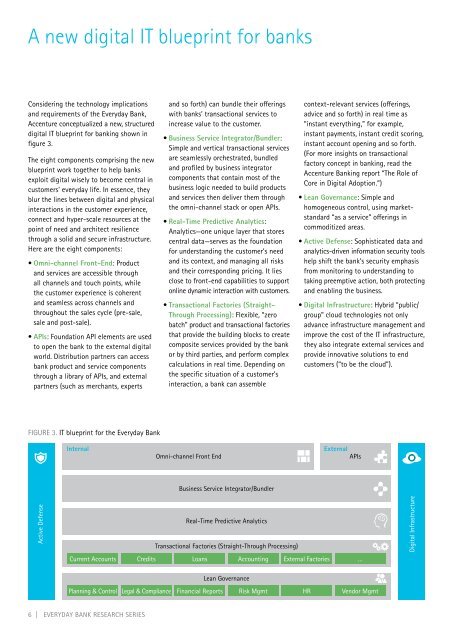Accenture-IT-Blueprint-for-the-Everyday-Bank
Accenture-IT-Blueprint-for-the-Everyday-Bank
Accenture-IT-Blueprint-for-the-Everyday-Bank
You also want an ePaper? Increase the reach of your titles
YUMPU automatically turns print PDFs into web optimized ePapers that Google loves.
A new digital <strong>IT</strong> blueprint <strong>for</strong> banks<br />
Considering <strong>the</strong> technology implications<br />
and requirements of <strong>the</strong> <strong>Everyday</strong> <strong>Bank</strong>,<br />
<strong>Accenture</strong> conceptualized a new, structured<br />
digital <strong>IT</strong> blueprint <strong>for</strong> banking shown in<br />
figure 3.<br />
The eight components comprising <strong>the</strong> new<br />
blueprint work toge<strong>the</strong>r to help banks<br />
exploit digital wisely to become central in<br />
customers’ everyday life. In essence, <strong>the</strong>y<br />
blur <strong>the</strong> lines between digital and physical<br />
interactions in <strong>the</strong> customer experience,<br />
connect and hyper-scale resources at <strong>the</strong><br />
point of need and architect resilience<br />
through a solid and secure infrastructure.<br />
Here are <strong>the</strong> eight components:<br />
• Omni-channel Front-End: Product<br />
and services are accessible through<br />
all channels and touch points, while<br />
<strong>the</strong> customer experience is coherent<br />
and seamless across channels and<br />
throughout <strong>the</strong> sales cycle (pre-sale,<br />
sale and post-sale).<br />
• APIs: Foundation API elements are used<br />
to open <strong>the</strong> bank to <strong>the</strong> external digital<br />
world. Distribution partners can access<br />
bank product and service components<br />
through a library of APIs, and external<br />
partners (such as merchants, experts<br />
and so <strong>for</strong>th) can bundle <strong>the</strong>ir offerings<br />
with banks’ transactional services to<br />
increase value to <strong>the</strong> customer.<br />
• Business Service Integrator/Bundler:<br />
Simple and vertical transactional services<br />
are seamlessly orchestrated, bundled<br />
and profiled by business integrator<br />
components that contain most of <strong>the</strong><br />
business logic needed to build products<br />
and services <strong>the</strong>n deliver <strong>the</strong>m through<br />
<strong>the</strong> omni-channel stack or open APIs.<br />
• Real-Time Predictive Analytics:<br />
Analytics—one unique layer that stores<br />
central data—serves as <strong>the</strong> foundation<br />
<strong>for</strong> understanding <strong>the</strong> customer’s need<br />
and its context, and managing all risks<br />
and <strong>the</strong>ir corresponding pricing. It lies<br />
close to front-end capabilities to support<br />
online dynamic interaction with customers.<br />
• Transactional Factories (Straight-<br />
Through Processing): Flexible, “zero<br />
batch” product and transactional factories<br />
that provide <strong>the</strong> building blocks to create<br />
composite services provided by <strong>the</strong> bank<br />
or by third parties, and per<strong>for</strong>m complex<br />
calculations in real time. Depending on<br />
<strong>the</strong> specific situation of a customer’s<br />
interaction, a bank can assemble<br />
context-relevant services (offerings,<br />
advice and so <strong>for</strong>th) in real time as<br />
“instant everything,” <strong>for</strong> example,<br />
instant payments, instant credit scoring,<br />
instant account opening and so <strong>for</strong>th.<br />
(For more insights on transactional<br />
factory concept in banking, read <strong>the</strong><br />
<strong>Accenture</strong> <strong>Bank</strong>ing report “The Role of<br />
Core in Digital Adoption.”)<br />
• Lean Governance: Simple and<br />
homogeneous control, using marketstandard<br />
“as a service” offerings in<br />
commoditized areas.<br />
• Active Defense: Sophisticated data and<br />
analytics-driven in<strong>for</strong>mation security tools<br />
help shift <strong>the</strong> bank’s security emphasis<br />
from monitoring to understanding to<br />
taking preemptive action, both protecting<br />
and enabling <strong>the</strong> business.<br />
• Digital Infrastructure: Hybrid “public/<br />
group” cloud technologies not only<br />
advance infrastructure management and<br />
improve <strong>the</strong> cost of <strong>the</strong> <strong>IT</strong> infrastructure,<br />
<strong>the</strong>y also integrate external services and<br />
provide innovative solutions to end<br />
customers (“to be <strong>the</strong> cloud”).<br />
FIGURE 3. <strong>IT</strong> blueprint <strong>for</strong> <strong>the</strong> <strong>Everyday</strong> <strong>Bank</strong><br />
Internal<br />
Omni-channel Front End<br />
External<br />
APIs<br />
Business Service Integrator/Bundler<br />
Active Defense<br />
Current Accounts<br />
Real-Time Predictive Analytics<br />
Transactional Factories (Straight-Through Processing)<br />
Credits<br />
Loans Accounting External Factories …<br />
Digital Infrastructure<br />
Lean Governance<br />
Planning & Control Legal & Compliance Financial Reports Risk Mgmt HR Vendor Mgmt<br />
6 | EVERYDAY BANK RESEARCH SERIES


